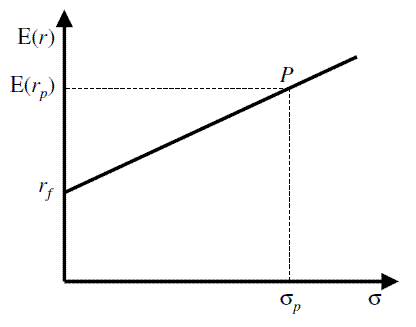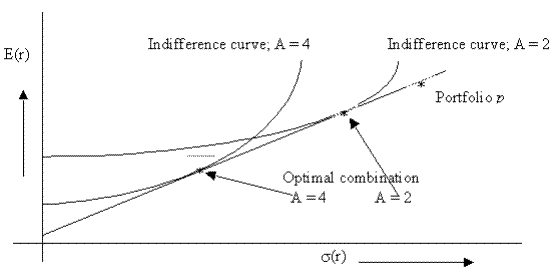- CFA Exams
- 2024 Level I
- Topic 9. Portfolio Management
- Learning Module 62. Portfolio Risk and Return: Part I
- Subject 4. Risk Aversion and Portfolio Selection
Why should I choose AnalystNotes?
AnalystNotes specializes in helping candidates pass. Period.
Subject 4. Risk Aversion and Portfolio Selection PDF Download
Risk Aversion
Every investor wants to maximize the investment returns for a given level of risk. Risk refers to the uncertainty of future outcomes. Risk aversion relates to the notion that investors as a rule would rather avoid risk. Given a choice of two investments with equal returns, risk-averse investors will select the investment with lower risk. Investors are risk-averse. Consequently, investors will demand a risk premium for taking on additional levels of risk. The more risk-averse the investor, the more of a premium he or she will demand prior to taking on risk.
Investors who do not demand a premium for risk are said to be risk-neutral (e.g., willing to place both a large and small bet on the flip of a coin and be indifferent) and those investors that enjoy risk are said to be risk seekers (e.g., people who buy lottery tickets despite the knowledge that for every $1 spent, on average they will get less than $0.1 back).
Example
Three investors, Sam, Mike, and Mary are considering two investments: A and B. Investment A is the less risky of the two, requiring an investment of $1,000 with an expected rate of return at 10%. Investment B also requires an investment of $1,000 and has an expected return of 10% but appears to have considerably more variability in potential returns than A. Sam requires a return of 14%, Mike requires 10%, and Mary seeks only an 8% return.
Question: Given the information above, which of the three investors is considered risk-averse?
Solution: Only Sam would be considered risk-averse. He is the only investor who demands a premium of return given the higher risk level. Mike would be considered risk-neutral since he demands no premium in return (despite the higher risk) and Mary would be considered a risk-seeker since she, in fact, will accept less return for a riskier situation.
Risk aversion implies that there is a positive relationship between expected returns (ER) and expected risk (Es), and that the risk return line (CML and SML) is upward-sweeping.
Evidence that suggests that individuals are generally risk-averse:
Purchase of insurance. Most investors purchase various types of insurance (e.g., life insurance, car insurance, etc.). By buying insurance, an investor avoids the uncertainty of a potential large future cost by paying the current known cost of the insurance policy.
Difference in the promised yield for different grades of bonds. The promised yield of a bond is its required rate of return. Different grades of bonds have different degrees of credit risk. The promised yield increases as you go from the lowest-risk grade (e.g., AAA) to a grade with higher risk (e.g., AA). That is, as the credit risk of a bond increases, investors will require a higher rate of return.
Utility Theory
Although investors differ in their risk tolerance, they should be consistent in their selection of any portfolio in terms of the risk-return trade-off. Because risk can be quantified as the sum of the variance of the returns over time, it is possible to assign a utility score (aka utility value, utility function) to any portfolio by subtracting its variance from its expected return to yield a number that would be commensurate with an investor's tolerance for risk, or a measure of their satisfaction with the investment. Because risk aversion is not an objectively measurable quantity, there is no unique equation that would yield such a quantity, but an equation can be selected, not for its absolute measure, but for its comparative measure of risk tolerance. One such equation is the following utility formula:
where A is the risk aversion coefficient (a number proportionate to the amount of risk aversion of the investor). It is positive for a risk-averse investor, zero for a risk-neutral investor, and negative for a risk seeker.
For example, if a T-bill pays 4%, and XYZ stock has a return of 12% and a standard deviation of 25%, and an investor's risk aversion coefficient is 2, his utility score of XYZ stock is equal to: 12% - 0.5 x 0.252 x 2 = 5.75%.
If someone were more risk-averse, we might use 3 instead of 2 to indicate the investor's greater aversion to risk. In this case, the above equation yields: 12% - 0.5 x 252 x 3 = 2.63%.
Since 2.63% is less than the 4% yield of risk-free T-bills, this risk-averse investor will reject XYZ stock in favor of T-bills while the other investor will invest in XYZ stock, since he assigns a utility score of 5.75% to the investment (which is higher than the T-bill yield).
A few conclusions about utility:
- It is unbounded on both sides.
- Higher return contributes to higher utility.
- Higher variance reduces utility.
- Utility does not measure satisfaction. It can be used to rank different investments.
- Utility cannot be compared among individuals; it's a very personal concept.
Indifference Curves
The set of all portfolios with the same utility score plots as an indifference curve.

An investor's indifference curves specify his or her preferences when making risk-return trade-offs. He or she will accept any portfolio with a utility score on his or her risk-indifference curve as being equally acceptable.
- The investments along each curve are equally attractive to the investor.
- The slope of the curves represents how risk-averse the investor is. Steep indifference curves indicate a conservative investor while flat indifference curves indicate a less risk-averse investor.
For a risk-averse investor:
- Every indifference curve runs from the southwest to the northeast.
- Every indifference curve is convex.
- The slope coefficient of an indifference curve is closely related to the risk aversion coefficient.
The Capital Allocation Line
Suppose we construct a portfolio (P) that combines a risky asset i with an expected return of ri and standard deviation of σi, and a riskless asset with a return of rf. Let w1 represent the fraction of the total portfolio value placed in the riskless asset.
- The portfolio return E(rp) is given by E(rp) = w1 rf + (1 - w1) E(ri).
- The portfolio standard deviation is given by σp = (1 - w1) σi
Example
Combine the S&P and a T-bill in a portfolio. E(rS&P) = 13%, σS&P = 20.3%, and rf = 3.8%. Some of the possible portfolios are:
- w1 = 0, E(rp) = E(rS&P) = 13%, and σp = 20.3%.
- w1 = 0.5, E(rp) = 0.5 x 0.038 + 0.5 x 0.13 = 8.4%, and σp = 0.5 x 20.3% = 10.1%.
- w1 = 1, E(rp) = rf) = 3.8%, and σp = 0%.
- w1 = -0.5, E(rp) = -0.5 x 0.038 + 1.5 x 0.13 = 17.6%, and σp = 1.5 x 0.203 = 30.5%. This means there is negative investment in the riskfree asset: the investor borrowed at the risk-free rate. This is called a leveraged position in the risky asset - some of the investment is financed by borrowing.
The portfolio's expected return and standard deviation obey a liner relation:


- The slope, [(E(ri - rf)/σi], is known as the portfolio's Sharpe measure or reward-to-variability ratio.
- The intercept is the risk-free rate.
- The line is called the capital allocation line (CAL). When i is a marker index portfolio, the line is called the capital market line (CML).
- A leveraged position is to the right of P.
CAL shows one simple fact: increasing the amount invested in the risky asset increases the expected return by a certain risk premium.
Now the investor must find the point of highest utility on CAL.
The optimal choice for an investor is the point of tangency of the highest indifference curve to the CAL - slope of the indifference curve is equal to the slope of the CAL.

The optimal w1 will be higher for investors with higher A.
User Contributed Comments 15
| User | Comment |
|---|---|
| haarlemmer | I am forced to buy insurance. |
| kuan | No one can be forced. |
| solie | We are all intrinsically risk-averse. |
| Done | Not really, I have clients that are fighter pilots |
| americade | all clients are greedy in investing, they never turn down more return but are constrained to take the highest return b/c of the higher probability of losing |
| Makamonds | You risk nothing you gain nothing |
| bobert | Done, they may be fighter pilots, but the point behind being risk averse is that that for a certain level of risk you want to have the highest returns. For example: Two different assets have the exact same level of risk exactly. That is the level of risk the investor is willing to assume. Asset 1 is expected to have a return of 7% while asset 2 is expected to have a return of 8%. Because all else is equal aside from expected return, any investor would logically pick the higher return. In the real world it is hard to say that because very few assets are exactly the same risk all the time. |
| tmillard | Did the example of the 3 people strike anyone else as backwards? I see what they are saying but I was looking at the 8% person as the risk adverse investor. Seems like the 14% would be the risk seeker because he needs to take on more risk to get the higher rate. I understand that he gets the risk premium on it, but when I htink of risk adverse i tend to think of a conservative investor. |
| steved333 | Risk averse just means that for any given return, most investors are going to go with the lowest level of risk. Even a fighter pilot would rather get 20% return with a 60% "guarantee" that it'll happen than only a 20% "guarantee"... |
| soarer1 | yup, thought it was backwards there. good for the brain though. |
| harveycaesar | Im an objective risk averse. I weigh things before i make a decision. I make sure that i can minimize or if possible eliminate uncertainties before i invest. How can i do that? i used quantitative tools to find out what should be the optimal decision. and most often i make the right one. hehehehe |
| Seemorr | I think they mean he's risk-averse because he's the only one who demands a premium for additional risk. The one who demands 8% is not less risk-averse because she's willing to accept less return for more risk. |
| Gooner7 | tmillard- I agree with you but this is how I thought of it: 3 investors are all considering buying a GE bond. Investor A says "For me to take on the credit risk of GE, it is going to cost atleast 14%" Investor B says "It's going to cost atleast 10%" Investor C "It's going to cost atleast 8%" |
| unknown | Theres a mistake in the paragraph utility theory. instead of 12%-0.5x25^2x3 it should say 12%-0.5x0.25^2x3. |
| TheCFAGuy | Risk averse is not being scared of risk, it is just wanting to get the most return possible for an equal amount of risk. Why would somebody risk losing everything for a 1% return if they can take the same risk but the payout is 10X. |

I am happy to say that I passed! Your study notes certainly helped prepare me for what was the most difficult exam I had ever taken.

Andrea Schildbach
My Own Flashcard
No flashcard found. Add a private flashcard for the subject.
Add